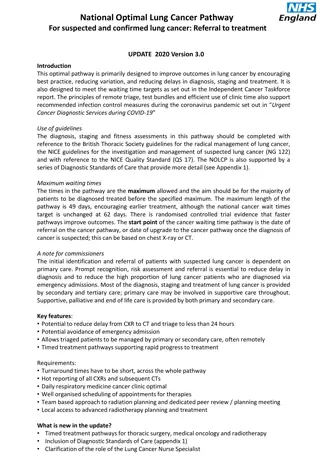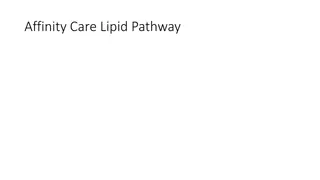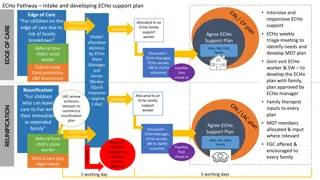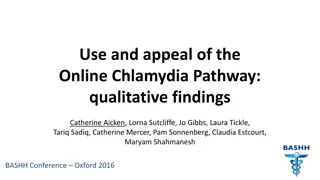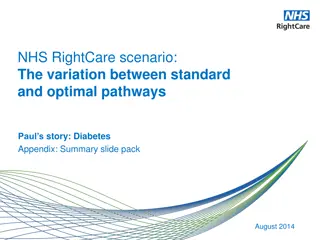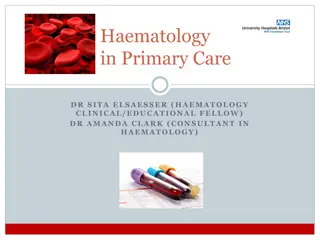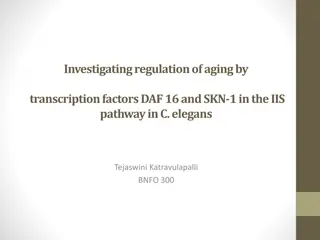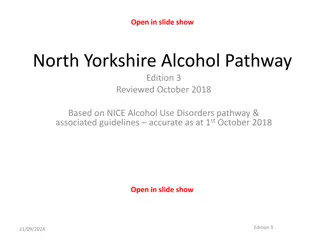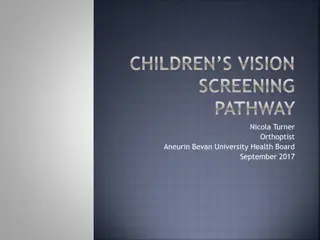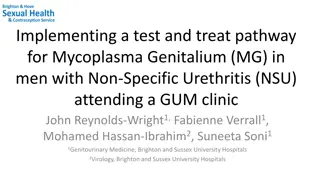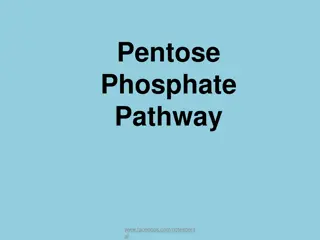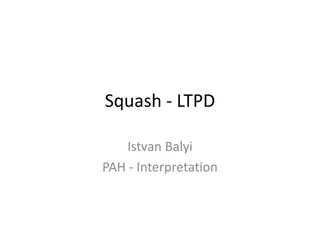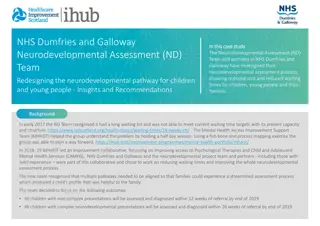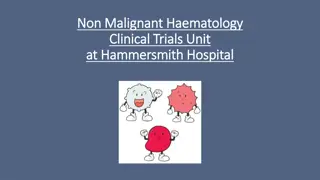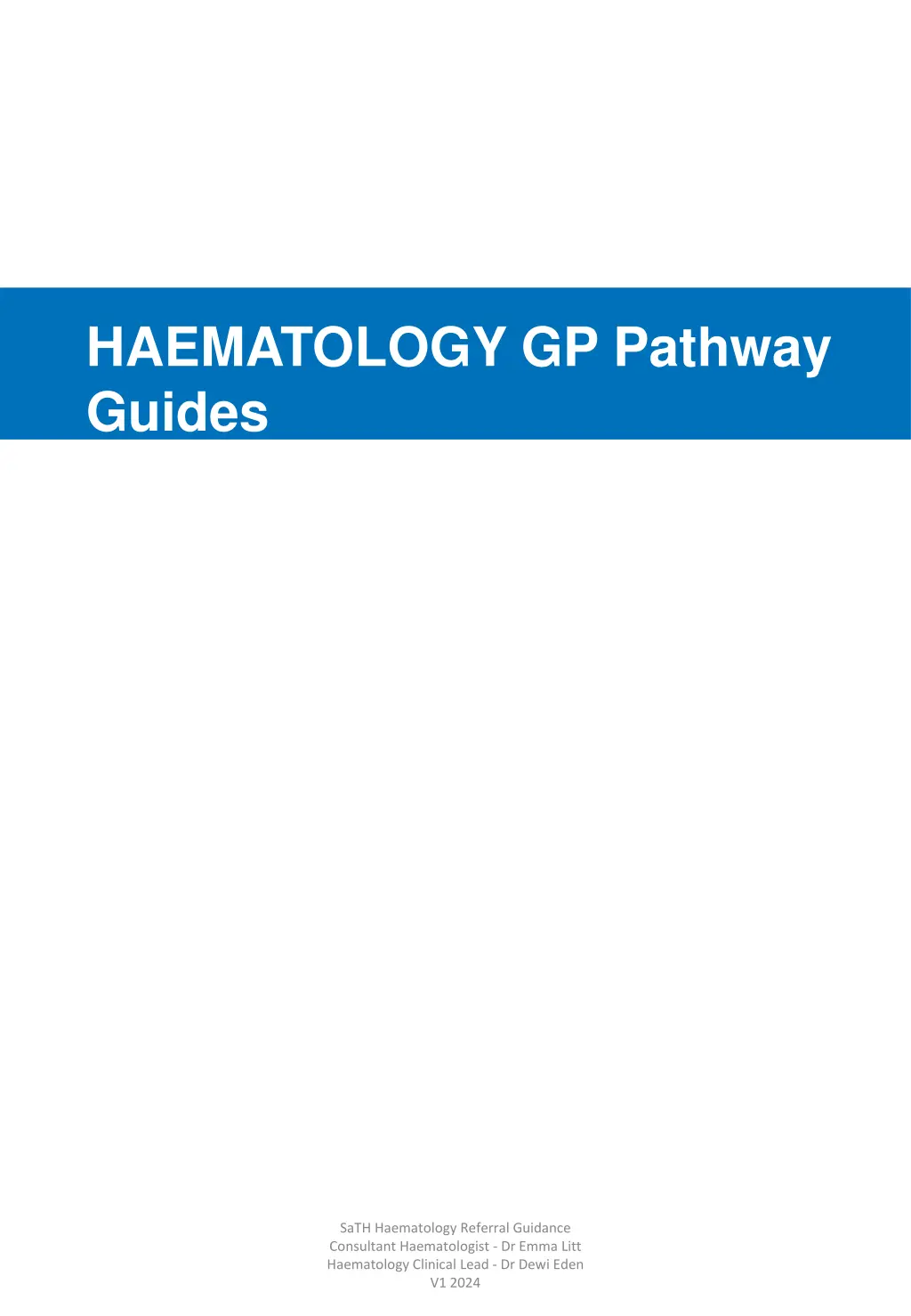
Haematology Referral Guidance for Lymphadenopathy and Splenomegaly
This guide provides detailed information on the referral process for patients presenting with lymphadenopathy and splenomegaly, highlighting important symptoms, causes, and appropriate management steps. It covers criteria for urgent referrals, associated conditions, and the role of Haematology specialists in the diagnostic pathway.
Download Presentation

Please find below an Image/Link to download the presentation.
The content on the website is provided AS IS for your information and personal use only. It may not be sold, licensed, or shared on other websites without obtaining consent from the author. If you encounter any issues during the download, it is possible that the publisher has removed the file from their server.
You are allowed to download the files provided on this website for personal or commercial use, subject to the condition that they are used lawfully. All files are the property of their respective owners.
The content on the website is provided AS IS for your information and personal use only. It may not be sold, licensed, or shared on other websites without obtaining consent from the author.
E N D
Presentation Transcript
HAEMATOLOGY GP Pathway Guides SaTH Haematology Referral Guidance Consultant Haematologist - Dr Emma Litt Haematology Clinical Lead - Dr Dewi Eden V1 2024
Contents Contents 1. 2. 3. 4. 5. 6. 7. 8. 9. 10. Thrombocytopenia 11. Paraprotein 12. Microcytic anaemia 13. Normocytic Anaemia 14. Macrocytosis 15. Pancytopenia 16. Hyperferrintinaemia Lymphadenopathy Splenomegaly Lymphocytosis Lymphopenia Neutropenia Neutrophilia Eosinophilia Polycythaemia Thrombocytosis SaTH Haematology Referral Guidance Haematology Consultant Dr Emma Litt Clinical Lead - Dr Dewi Eden
Lymphadenopathy B Symptoms Lymphadenopathy Weight loss >10% over 6 months Drenching sweats, Unexplained fever >38 C Lymphadenopathy- look for causes Lymphadenopathy associated with: Localised unexplained adenopathy OR Concerns of metastatic node B symptoms Liver and spleen enlargement Rapidly increasing in size Generalised lymphadenopathy Cytopenias Appropriate referral to surgical team or ENT for biopsy/ radiological biopsy (US or CT guidance) Refer to Haematology on urgent (suspected cancer) pathway Causes: Acute and chronic bacterial infections Syphilis Auto immune conditions Malignancy (haematological/ metastatic) Viral infections (including HIV, EBV, CMV) SaTH Haematology Referral Guidance Haematology Consultant Dr Emma Litt Clinical Lead - Dr Dewi Eden
Splenomegaly B symptoms Splenomegaly NB: Spleen increases with height. On average increases in length by 0.2 cm for every inch > 6ft weight loss >10% over 6 months drenching sweats, unexplained fever >38 C Spleen >13cm B symptoms Cytopenias Paraprotein Lymphadenopathy high haemoglobin or increased platelet count Evidence of haemolysis High WBC Leuco-erythroblastic blood film If Criteria not met for urgent referral look for causes If no obvious cause refer to Haematology Refer to Haematology on urgent (suspected cancer) pathway Causes Infections Viral (HIV, EBV, CMV) and parasitic Alcohol Liver disease Cardiac failure Autoimmune Lymphoproliferative disorders Myeloproliferative disorders (such as CML or myeloproliferative disorders) Haemolysis SaTH Haematology Referral Guidance Haematology Consultant Dr Emma Litt Clinical Lead - Dr Dewi Eden
Lymphocytosis B Symptoms Lymphocytosis Weight loss >10% over 6 months Drenching sweats, Unexplained fever >38 C Lymphocytosis >5x109/L Lymphocytosis 5-20x109/L Lymphocytosis >20x109/L Other cytopenias B symptoms Lymphadenopathy Splenomegaly Repeat FBC in 2 months and look for causes Refer urgently (suspected cancer) to haematology If persistent >10x 109/L refer routinely to Haematology If <10x 109/L monitor 6 monthly Causes: Smoking Viral infections especially Glandular fever Lymphoproliferative disorders (such as CLL) Bacterial infections Post-splenectomy Rheumatoid arthritis SaTH Haematology Referral Guidance Haematology Consultant Dr Emma Litt Clinical Lead - Dr Dewi Eden
Lymphopenia Red Flag signs Lymphopenia Weight loss Fevers Drenching night sweats Recurrent infections Lymphocytes<1.0x109/L If >0.5x109/L and >70 years of age no need for further investigations Lymphocytes <1 and red flag symptoms examine for lymph nodes and if present refer to Lymphocytosis pathway If no red flag symptoms repeat FBC in 3 months and look for causes Refer to haematology only if suspicious of lymphoma Causes: Elderly patients Infections including HIV, hepatitis B and C Excess alcohol Malnutrition Medications-steroids, chemotherapy, antiepileptics, antidepressants Systemic immune conditions Systemic illness(renal, cardiac, liver failure, malignancy) Lymphoma SaTH Haematology Referral Guidance Haematology Consultant Dr Emma Litt Clinical Lead - Dr Dewi Eden
Neutropenia Causes To Consider Neutropenia Drugs Myeloma B12/folate deficiency Autoimmune Any viral infection including HIV/Hepatitis B/C Neutrophil Count <1.8 x 109/L Neutrophil Count <0.5 x 109/L Neutrophil Count 0.5 - 1 x 109/L Neutrophil Count >1 x 109/L Repeat FBC in 1 week and look for causes Repeat FBC in 6 weeks and look for causes Evidence of sepsis Patient well with no fever If persistently <1.0 x 109/L and no obvious cause found, refer to Haematology If between 1.0-1.8x 109/L then monitor annually. Consider repeat in 1 week If no obvious cause (see box above) refer urgently to Haematology Admit to hospital for management of Neutropenic sepsis Note: A neutrophil count of between 1-5 - 2.0 x 109/l whilst below the normal range is unlikely to be of any clinical significance. People of Afro-Caribbean or Middle Eastern ethnicity have a lower normal range for the neutrophil count (benign ethnic neutropenia) 1 - 1.8 x 109/l. This is of no clinical consequence. Only refer if their neutrophils are <1.0 x 109/l on repeat testing. SaTH Haematology Referral Guidance Haematology Consultant Dr Emma Litt Clinical Lead - Dr Dewi Eden
Neutrophilia Neutrophilia Neutrophil count elevated If chronic myeloid leukaemia is suspected you will be contacted by a haematologist to organise urgent admission or outpatient review and further investigations as indicated Assess if there is a clear cause for this: Infection Inflammation Steroids Pregnancy Smoking Underlying neoplasia If cause unclear check: Blood Film, if not done ESR CRP U&E LFT ANA & Rheumatoid Factor PSA etc. led by history Neutrophil count >15 X 109/L, persistent at 3 months & unexplained: Refer to Haematology SaTH Haematology Referral Guidance Haematology Consultant Dr Emma Litt Clinical Lead - Dr Dewi Eden
Eosinophilia Red Flag Signs Eosinophilia If Eosinophil count>2.5 look for signs of organ damage and consider urgent admission: Venous Thromboembolism Congestive Heart Failure Gastrointestinal Neurological Pulmonary Eosinophils >0.5x109/L Repeat FBC in 2 weeks and look for causes if > 1.5 (such as IgE level, Autoimmune Screen, Stool Cultures) If secondary cause found, treat as appropriate No cause found If <5.0 x 109/L and persistent for 3 months If >5.0 x 109/L and only if no other cause Refer routinely to Haematology Refer urgently to Haematology Causes Asthma / atopic dermatitis / acute urticarial Infections: especially those due to parasites (most commonly helminthes - hookworm, schistosomiasis - but also giardiasis or other protozoal infections and strongyloides) Drugs (penicillins, carbamazepine, sulphonamides are common but any drug is a possible cause) Connective tissue disease (rheumatoid arthritis, polyarteritis nodosa, Wegener's granulomatosis) Solid malignancy (breast, renal and lung cancer) Respiratory disease (Churg-Strauss syndrome, bronchiectasis, cystic fibrosis) Myeloproliferative disorders SaTH Haematology Referral Guidance Haematology Consultant Dr Emma Litt Clinical Lead - Dr Dewi Eden
Polycythaemia Polycythaemia High haematocrit (Hct) >0.51 in men, >0.48 in women Hct Male > 0.600, Female > 0.560 in the absence of congenital cyanotic heart disease Recent arterial or venous thromboembolism Neurological symptoms Visual Loss Abnormal bleeding Does not meet criteria for urgent referral- repeat in 2 months and consider causes (see below) If no obvious secondary cause and persistent on 2 samples 1-2 months apart, refer to Haematology routinely. Refer to urgently to Haematology Causes Drugs diuretics, testosterone, anabolic steroids, SGLT2 inhibitors Lifestyle choices -smoking, alcohol Hypoxia SaTH Haematology Referral Guidance Haematology Consultant Dr Emma Litt Clinical Lead - Dr Dewi Eden
Thrombocytosis Thrombocytosis Platelets >450x109/L Platelets >1000 x 109/L Recent arterial or venous thromboembolism Neurological symptoms Abnormal bleeding Platelets >450 x 109/L Repeat FBC in 6 weeks and look for causes Refer urgently to Haematology If persistent >450 x 109/L and no obvious cause refer routinely to Haematology Causes Iron Deficiency Anaemia Malignancies especially the LEGO cancers (lung, endometrium, gastric and oesophageal) Inflammation Infection Post-Splenectony and Hyposplenism (e.g. Coeliac Disease) Myeloproliferative Disorders Post-Operatively *Note: Persistent thrombocytosis has been shown in large scale studies to be a precursor feature of malignancy. Therefore, if no immediate cause is found, close clinical follow-up is advised. SaTH Haematology Referral Guidance Haematology Consultant Dr Emma Litt Clinical Lead - Dr Dewi Eden
Thrombocytopenia If platelets are less than 50x109/L please stop all antiplatelet agents and anticoagulation as unsafe to continue. Thrombocytopenia Please refer urgently to Haematology Platelets<150x109/L Platelets <50x???/OR Associated with Cytopenias, Splenomegaly Lymphadenopathy Pregnancy Upcoming surgery Platelets <20 Active Bleeding Blasts In Film Fragments In Film Altered Conscious Level Or Confusion Platelets 50-100 x ???/L D/W on call Haematology to arrange urgent direct assessment Repeat FBC in 4 weeks and look for causes Repeat FBC in 1 week If persistent refer urgently to Haematology If persistent and unexplained refer to Haematology routinely Causes Spurious result from clumping please look at blood film report and repeat FBC for platelet clumping in citrate using citrated (blue top) bottle Immune thrombocytopenic purpura (ITP) Alcohol Liver dysfunction Medications B12/folate deficiency HIV/Hepatitis B/C Bone marrow failure/infiltration SaTH Haematology Referral Guidance Haematology Consultant Dr Emma Litt Clinical Lead - Dr Dewi Eden
Paraprotein End Organ Damage: Hypercalcaemia Unexplained renal impairment Anaemia or other cytopenias Bone pain or pathological fracture Paraprotein on Serum Protein Electrophoresis Paraprotein <30 SFLC ratio <8 or >0.1 No Immunoparesis No End Organ Damage Any of following: Paraprotein >30 SFLC ratio >8 or < 0.1 Immunoparesis (low IgM/G/A) End Organ Damage Lymphadenopathy Splenomegaly Low Risk MGUS High Risk MGUS IgG <15 IgM and IgA <10 SFLC ratio <8 or >0.1 No Organ Damage IgG>15 IgM and Ig A>10 Urgent (suspected cancer) referral to Haematology - ? Myeloma/LPD Note: Urgent referral to Haematology Non-urgent referral to Haematology If there are concerns regarding the interpretation of paraprotein or Serum Free Light Chain results please discuss with the Haematology team. *Note: Guideline intended to aid patient discussion and risk stratification on finding a paraprotein. Further investigations, patient education and ongoing monitoring will occur through haematology following review in haematology OPD SaTH Haematology Referral Guidance Haematology Consultant Dr Emma Litt Clinical Lead - Dr Dewi Eden
Microcytic Anaemia Microcytic Anaemia Hb <120g/L Woman Hb<130g/L Man AND MCV <80 Ferritin <30mcg/L Or <50mcg/L with Iron Sats <20% ?h/o menorrhagia, bowel symptoms, bleeding Rpt FBC, ferritin Is a thalassaemia/ Hb variant likely (ethnic origin)? Ferritin >50mcg/L Commence oral iron replacement Yes Possible Anaemia of chronic disease / inflammation Haemoglobinopathy testing advised If cause unknown If cause known No Hb abnormality found Hb Treat underlying cause Refer to Haematology or through advice and guidance if Hb <100g/L no evidence of chronic disease/ inflammation abnormality found Check patient diet, TTG antibody, consider referral to Gastroenterology/ Gynaecology. Patients with IDA DO NOT need to be referred to Haematology unless intolerant of oral iron Possible alpha thalassaemia. If additional concern, discuss through advice and guidance Refer to Haematology SaTH Haematology Referral Guidance Haematology Consultant Dr Emma Litt Clinical Lead - Dr Dewi Eden
Normocytic or Macrocytic Anaemia Hb <120g/L Woman Hb<130g/L Man AND MCV >80 Check: FBC Blood Film if not done UE/LFT TFT Vit B12 Folate Ferritin Iron Saturations Reticulocyte count Serum Immunoglobulins Serum Free Light Chains All tests normal or reticulocytes low or picture unclear Ferritin <50mcg/L, low Vit B12 or Folate Elevated reticulocyte count Paraprotein detected Deranged renal function Thyroid function abnormal Advice and guidance if if Hb < 100 and not anaemia of chronic inflammation ? MDS Look for evidence of bleeding or haemolysis * and refer to appropriate department Suggest replace deficiency and assess for underlying cause Treat thyroid dysfunction and repeat testing 4-6 weeks Refer to Paraprotein guideline Suggest referral to Renal team *Note: Laboratory markers of possible haemolysis include raised bilirubin, raised reticulocytes and raised LDH. Discuss with on-call haematologist/A&G if suspicious of haemolysis SaTH Haematology Referral Guidance Haematology Consultant Dr Emma Litt Clinical Lead - Dr Dewi Eden
Macrocytosis Macrocytosis With/without anaemia Check Notes *A high MCV can be a normal physiological finding in pregnancy Alcohol history Medication (e.g.methotrexate, metformin, some anticonvulsants, hydroxycarbamide, antiretroviral drugs etc.) Blood Film Vit B12 and folate Reticulocyte count/LDH LFT TFT Serum immunoglobulins Serum Free Light Chains Family history High Mean Cell Volume (MCV)* Repeat FBC to ensure not spurious (e.g. delayed transport/ overheating etc.) MCV remains raised If Vit B12/folate deficient and Hb <80g/L or other cytopenias Consider referral to Haematology if: No secondary cause and MCV>105fL if other cytopenias or>110fL in the absence of other cytopenias No history of liver disease Dysplasia on blood film Paraprotein detected Repeat FBC with reticulocyte count 5-7 days after starting replacement therapy to assess response. The reticulocyte count should increase on treatment. If no improvement in Hb after 2 weeks, refer to Haematology *Note: Cytopenia due to haematinic deficiency can take 8-12 weeks to fully resolve once treated SaTH Haematology Referral Guidance Haematology Consultant Dr Emma Litt Clinical Lead - Dr Dewi Eden
Pancytopenia Pancytopenia Clinical assessment and assessment of severity Severe if any of: Hb <80 g/L Platelets < 30 x 109/L Neutrophils <0.5 x 109/L Consider reversible causes: Drugs e.g.methotrexate; chemotherapy; carbimazole, clozapine Haematinic deficiency Check: Vit B12/folate Reticulocyte count U&E/LFT Bone profile Request blood film if not already available Immunoglobulins and serum free light chains Severe features present but clinically stable Non-severe No clear cause Hb < 100 x 109/L Platelets < 100 x 109/L Neutrophils <1 x 109/L Unwell/ febrile/ other clinical concerns Blood film shows concerning features E.g. evidence of: DIC Blasts Leucoerythroblastic features Clear cause Discuss with on- call Haematologist Consider admission Routine referral to general Haematology clinic Treat underlying cause and monitor to ensure resolves ? possible reversible cause Follow advice from blood film report or discuss with on call Haematologists No Yes Urgent (suspected cancer) referral to Haematology Treat and discuss with Haematology team SaTH Haematology Referral Guidance; Haematology Consultant Dr Emma Litt Clinical Lead - Dr Dewi Eden
Hyperferritinaemia Hyperferrinitinaemia *Note: it is recommended to screen ADULT first degree relatives (siblings) of known C282Y HOMOZYGOTES ONLY for genetic haemochromatosis due to their increased risk for C282Y homozygosity. Screening should be performed by ferritin, iron studies and genetic testing. HFE testing can be performed in primary care and does not require referral to haematology or clinical genetics (see text). HFE testing in children is inappropriate. If patient has had a private HFE test which confirms GH, please refer to haematology. Raised ferritin > 300 g/L male >200 g/L female Check Repeat serum ferritin Full Blood Count, Liver Function Test, Transferrin Saturation If Tsat is NORMAL consider: If Ferritin >1000mcg/L and normal iron sats ONLY if FBC is NORMAL & Tsat is RAISED (>50% male, 40% female) If FBC abnormal & Tsat raised (>50% male, 40% female) Alcohol excess Inflammatory disorders Metabolic syndrome Malignancy Consider iron loading anaemia Proceed to HFE genotyping* Consider non- haematological cause ** Yes No Treat underlying cause and monitor to ensure resolves If Ferritin <100mcg/L repeat in 6 monhts ** Causes: Infection including COVID Iron therapy and blood transfusions Inflammation Malignancy Liver disease including fatty liver disease (LFTS may be normal; consider USS abdomen) Metabolic syndrome Alcohol excess SaTH Haematology Referral Guidance; Haematology Consultant Dr Emma Litt Clinical Lead - Dr Dewi Eden



